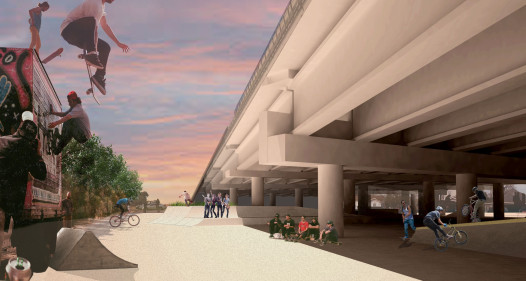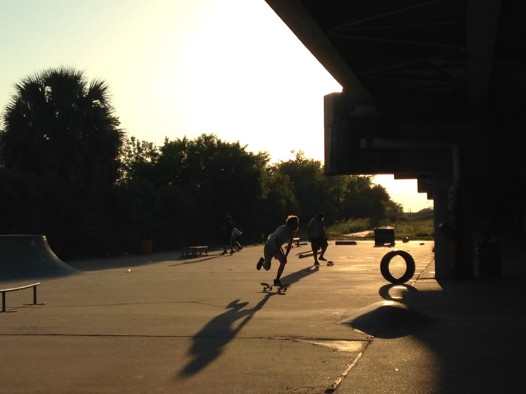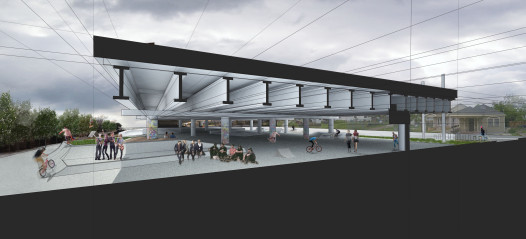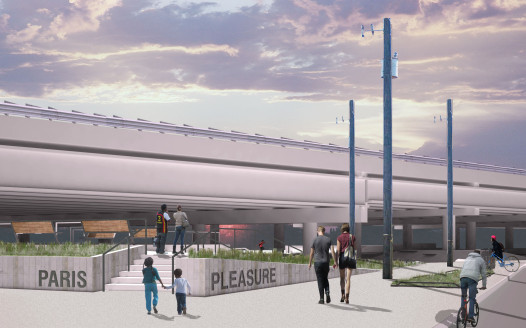
A rendering of the ‘Sunny Side’ section of Parisite Skate Park.
Credit Emilie Taylor / Tulane City Center
Lots of areas in New Orleans flood. There are many ways to handle neighborhood flooding beyond pumping stations and sewers. Some cities have realized that skate parks, of all places, can be used to manage water rather well. New Orleans’ new skate park is being designed as a water management tool.
It’s loud underneath the 610 Interstate at Paris Road. Cars and trucks barrel overheard, and the overpass rumbles and thumps. But there are other noises contributing to the sea of sound: skateboards.
“This space actually used to be a park. Dutch Moriale made it a park in 1980,” says Jackson Blalock, a skater who’s also studied architecture. He’s with Transitional Spaces, a local non-profit that wants to put a skate park in every neighborhood.
“It was vacated and torn down sometime between then and now, and had become a burned-out car graveyard. Skaters started cleaning it up once they realized they could skate on this huge 50,000-square-foot expanse of concrete.”
When the city elders first got wind, they wanted to shut it down. But Jackson says once officials realized this location used to be a park, they decided to get involved. So did Tulane City Center, the research and outreach arm of Tulane’s architecture school.
“The skate park location is underneath the 610 at Paris Ave — the skaters refer to it as the ‘Paris-site’, which is why it’s ‘Parasite’,” says Emilie Taylor, Design Build Manager at Tulane City Center. Taylor liked the idea of doing something useful with the neglected underbelly of the interstate. She also liked that Transitional Spaces’ mission wasn’t just about skate parks, but sustainable land use. In fact, many skate parks are built on unused public space.
“A lot of them originated in civic infrastructure city drainage canals and things like that.”

The “Sunny Side” area of Parisite Skate Park is currently in use, but awaits a re-design. credit: Laine Kaplan-Levenson
While designing a skate park under the 610 interstate, Blalock noticed he could go beyond sustainable land use, and address a specific need in New Orleans: water management.
“One thing that we noticed really early on is that when it rains it goes pouring off the side of the interstate. So when you have a rainstorm of any size that’s a huge amount of water hitting down. All right, where is that going? Straight off into the city’s pumping stations.”
So with a little design, Parisite Skatepark will now help the city manage floodwater. This is done with rain gardens — dug-out areas filled with layers of gravel and sand, and topped with planted wetlands plants. Taylor says the point of a rain garden is to capture and slow down the water on site, instead of sending it straight to the storm sewers.
“Because anything that goes to the storm sewers has to be pumped out, and we all know during a heavy rain the pumps gets overloaded really fast, so the more we can slow water on site, and return it to the ground, the better it is for all of us.”

A section perspective rendering, showing all planned elements for Parisite Skate Park, including the gardens.
Credit Emilie Taylor / Tulane City Center
The next thing to do was bring in a landscape architect. Dana Brown and Associates is a landscape architecture and planning firm specializing in water management. Brown, who just came out with the book “Using Plants for Stormwater Management” (published by LSU Press), says that detaining water at the skate park can help reduce flooding in the surrounding neighborhood.
“It’s really all about what we call localized flooding. A lot of people see that in their neighborhoods. It’s not about a hurricane. It’s about a low point — it all collects there. So somebody can’t get in their house, or they can’t get in that park, or they can’t get in their driveway, or they’re worried about it getting up to their doorstep.”
So the Parisite Skate Park becomes a good neighbor. But city officials wanted one more assurance before they got on board. What has pushed this skate park through is making sure that people who have no interest in skateboarding can use it, too. It will have lots of signage, a welcoming entryway, and grassy seating areas for that.

Plans for Parisite’s entrance, on the Pleasure Street side.
Credit Emilie Taylor / Tulane City Center
Emilie Taylor emphasizes this approach when she states, “It’s important to us that we make a place that’s a park that happens to be a great place to skate.”
But the skaters are still the most excited. Since L’il Wayne’s Trukstop Skate Park in the lower 9th Ward failed, this will be the first official skate park in New Orleans. Now the team is waiting on some final approvals from the city before breaking ground. Taylor thinks that should happen in June. And Jackson Blalock hopes construction is complete by the end of the summer.
 NOLAbeings Multimedia artist Claire Bangser created NOLAbeings as a portrait-based story project that marries...
NOLAbeings Multimedia artist Claire Bangser created NOLAbeings as a portrait-based story project that marries...  Voodoo in New Orleans: Reviving history: New Orleans fortune telling This article takes a deep dive into the history of Voodoo in New Orleans, its hybridization with Catholicism, and its present-day place in the city's culture. The author visits fortune-tellers in the French Quarter, using their guidance as a tool for introspection rather than a deterministic predictor of the future. Through her experiences in New Orleans, the author feels a mystical connection to both the past and the future.
Voodoo in New Orleans: Reviving history: New Orleans fortune telling This article takes a deep dive into the history of Voodoo in New Orleans, its hybridization with Catholicism, and its present-day place in the city's culture. The author visits fortune-tellers in the French Quarter, using their guidance as a tool for introspection rather than a deterministic predictor of the future. Through her experiences in New Orleans, the author feels a mystical connection to both the past and the future. 